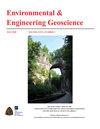自然泥石流中速度剖面的测量:泥幕后的视角
IF 1
4区 工程技术
Q4 ENGINEERING, ENVIRONMENTAL
引用次数: 3
摘要
自然泥石流的内部变形行为对泥石流灾害缓解的模型开发和模型试验具有重要意义。由于自然泥石流的可预见性低,破坏力大,迄今为止,对其速度剖面的测量只进行了初步的尝试。在这篇文章中,我们介绍了测量现场速度剖面和流动参数(如流动深度、基底法向应力和孔隙流体压力)的最新进展。为此,在Gadria河(IT)中建造了一个鳍形监测屏障,横向携带一对电导率传感器阵列。我们介绍了两个泥石流事件的结果,每个事件的体积约为5000立方米。与2017年7月10日的第一次活动相比,2017年8月19日的第二次活动在视觉上更具流动性。两种泥石流在纵向上都表现出明显的流深、流密度等流动特性变化。在流动的某些部分,液化比达到了一致的值。7月事件的速度曲线大部分呈上凹型,而8月流动性更强的事件的速度曲线则呈线性到凸型。尽管受到壁面边界粗糙度和偶尔在力板和压力传感器上的沉积物沉积的限制,这些测量结果获得了对真实尺度泥石流动力学的新见解。本文章由计算机程序翻译,如有差异,请以英文原文为准。
Measurements of Velocity Profiles in Natural Debris Flows: A View behind the Muddy Curtain
The internal deformation behavior of natural debris flows is of interest for model development and model testing for debris-flow hazard mitigation. Up to now, only a view attempts were made to measure velocity profiles in natural debris flows due to low predictability and high destructive power of these flows. In this contribution we present recent advances of measuring in-situ velocity profiles together with flow parameters like flow depth, basal normal stress, and pore fluid pressure. For that a fin-shaped monitoring barrier was constructed in the Gadria creek (IT), laterally carrying an array of paired conductivity sensors. We present results from two debris-flow events with volumes of around 5,000 m3 each. Compared to the first event on July 10th, 2017, the second event on August 19th, 2017, was visually more liquid. Both debris flows exhibited significant longitudinal changes of flow properties like flow depth and density. The liquefaction ratios reached values up to unity in some sections of the flows. Velocity profiles for the July event were mostly concave up, while the profiles for the more liquid event in August were linear to convex. Though limited by boundary roughness at the wall and occasional sediment deposition on the force plates and pressure sensors, these measurements gain new insights of the dynamics of real-scale debris flows.
求助全文
通过发布文献求助,成功后即可免费获取论文全文。
去求助
来源期刊

Environmental & Engineering Geoscience
地学-地球科学综合
CiteScore
2.10
自引率
0.00%
发文量
25
审稿时长
>12 weeks
期刊介绍:
The Environmental & Engineering Geoscience Journal publishes peer-reviewed manuscripts that address issues relating to the interaction of people with hydrologic and geologic systems. Theoretical and applied contributions are appropriate, and the primary criteria for acceptance are scientific and technical merit.
 求助内容:
求助内容: 应助结果提醒方式:
应助结果提醒方式:


